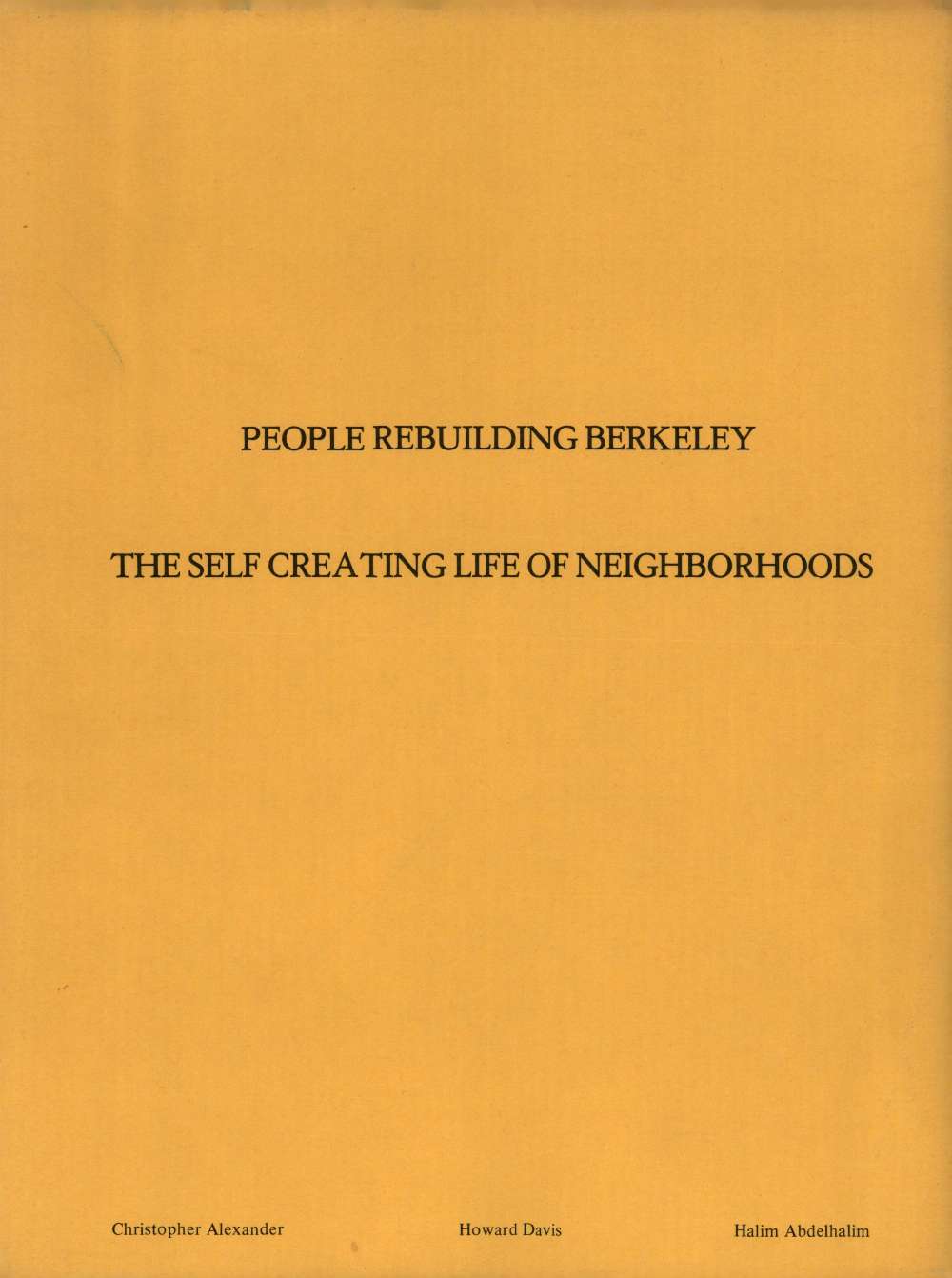
People Rebuilding Berkeley – The Self-Creating Life of Neighborhoods
20/11/1974201-page report which includes a 3-page “Memorandum to the Master Plan Revision Committee, City of Berkeley”. It demonstrates an early approach to the idea of piecemeal development applied to the organic fabric of streets in a town. It proposes the following hypothesis to be tested: “There is one primary process, which plays the central role in the life of a town. This is the process by which the energy of the people of the town is liberated, and being liberated, coalesces in the creation, growth and constant repair of the common land; and proposes the local neighborhood as the fundamental unit for the Berkeley Master Plan and the planning process.” The basic point introduced was that the urban environment can be ordered by a small, step by step piecemeal process in which individuals do things of various sizes and bugets, under the assumption that the city the size of Berkeley, with an annual budget of $20.000.000 (in 1974) would allocate a total of $2.000.000 to this process, thus allowing 200 projects a year to happen.
-
A New Approach to Design and Construction Management
A new kind of design/construction/management process, especially for large projects, is required, which will allow the building to be conceived, designed and built so that it comes to life. Below are the ground rules of such a process, already tried ...
-
Development of first Patterns and Pattern Languages
The first patterns were developed in 1967 by a group of people working together with Christopher Alexander in the Center for Environmental Structure. Between 1968 and 1976 the first pattern languages were developed and tested for particular projects undertaken by ...
-
Master Planning as a Dynamic Process - Organic Order and Piecemeal Growth
It is simply not possible to fix today, in a Master Plan, what the environment should be like in the future, and then to steer the piecemeal process of development toward that fixed, imaginary world. Instead, planning and construction will ...
-
A Pattern Language
01/01/1977
“A Pattern Language” is the second volume of “The Center for Environmental Structure Series” on architecture published by Oxford University Press. You can use this book to design a house for yourself with your family; you can use it to ...
-
People Rebuilding Berkeley - The Self-Creating Life of Neighborhoods
01/01/1985
The book is a reprint of the 1974 project report with the same title, addressed to the Master Plan Revision Committee of the City of Berkeley. It demonstrates an early approach to the idea of piecemeal development applied to the ...
-
The Rebirth of a Neighborhood - Grant Application
26/11/1975
Grant application to the U.S. Office of Education of the Department of Health, Education, and Welfare with a proposal for further development of the “The Rebirth of a Neighborhood” project; same report filed again in 1977. Consists of two parts: ...
-
The Rebirth of a Neighborhood - Grant Application
28/02/1977
Second grant application to the U.S. Office of Education of the Department of Health, Education, and Welfare with a proposal for further development of the “The Rebirth of a Neighborhood” project. Bound document consisting of two parts; the 53-page first ...
-
"Small Open Spaces" Pattern
01/07/1968
Early formulation of pattern on a 2-page format with: Title of Pattern, Photo, Statement of Problem, Solution, Diagram, Author/s, Date, revision Date and Notes; included in “A Pattern Language”, pattern #161 Small Public Squares. Revised in Sep-1970 .
-
"Green Streets" Pattern
01/01/1968
Early formulation of pattern on a 2-page format with: Title of Pattern, Photo, Statement of Problem, Solution, Diagram, Author/s, Date, revision Date and Notes; included in “A Pattern Language”, pattern #51 Green Streets. Revised in Sep-1970.
-
"Public Outdoor Room" Pattern - Original
01/08/1969
Early formulation of pattern on a 2-page format with: Title of Pattern, Photo, Statement of Problem, Solution, Diagram, Author/s, Date, revision Date and Notes; included in “A Pattern Language”, pattern #69 Public Outdoor Room. Revised May-1970.
-
People Rebuilding Berkeley: Photographs of drawings
01/01/1974
Site plan sketch showing repair of the streets of a Berkeley neighborhood in a 10-year period.
-
People Rebuilding Berkeley: Photographs of drawings
01/01/1974
Neighborhood simplified maps depict the three stages of the growth a neighborhood, as it develops during the period of ten years: The 1st stage depicts the neighborhood at the beginning, the 2nd stage after four years of development and the ...
-
People Rebuilding Berkeley: Photographs of drawings
01/01/1974
Three maps depicting the “impact of the many hundreds of small acts performed over ten years in the lives of small neighborhoods” in the following: House Clusters and Common Land; Path Network Activity Nodes; Work Communities and Accessible Green.




 Go Back
Go Back